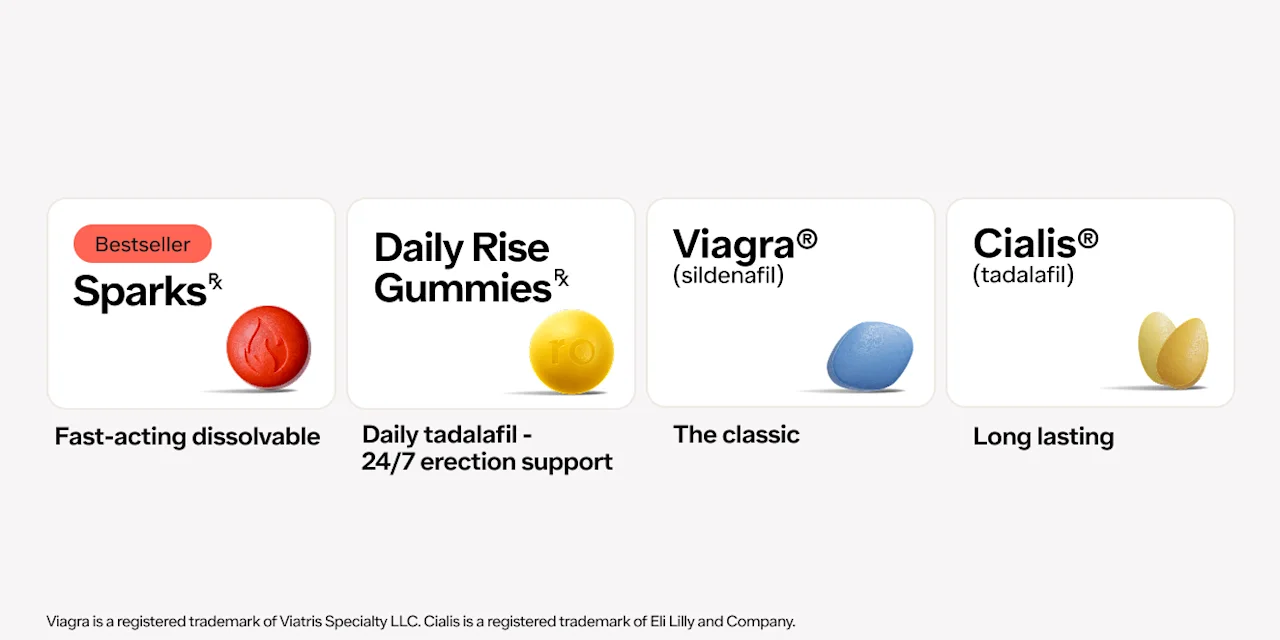Here's what we'll cover
Here's what we'll cover
Here's what we'll cover
If you’re looking for ED medications to treat erectile dysfunction (ED), vardenafil (formerly Levitra, Staxyn) and tadalafil (brand name Cialis) may have come up in your research or in your conversations with your doctor.
Both tadalafil and vardenafil are PDE5 inhibitors, like Viagra (sildenafil). They work by increasing blood flow to the penis. This enables you to get and maintain an erection once you’re already feeling aroused. Neither medication can make you horny (the ball’s in your court on that one), but once you’re in the mood, they can help you get and stay hard.
While the two ED medications share many side effects and interactions, there are some key differences between vardenafil vs. tadalafil regarding price, doses, and more. Which is faster and which works longer? We will break down what you need to know to decide between these two medications.
Cialis Important Safety Information: Read more about serious warnings and safety info.
Viagra Important Safety Information: Read more about serious warnings and safety info.
Vardenafil vs. tadalafil: key similarities
Both vardenafil and tadalafil are PDE5 inhibitors, a group of prescription medications that treat ED by boosting blood flow to the penis, leading to stronger erections and increased satisfaction with intercourse.
Vardenafil and tadalafil may also help with premature ejaculation (PE), according to some research.
Both medications can be taken orally as-needed, about 1 hour before you plan on having sex.
They share several side effects, including headache, flushing, indigestion/heartburn, back pain, and runny nose or congestion. Most of these are manageable and temporary.
Vardenafil vs. tadalafil: key differences
While both medications treat ED, tadalafil can also be prescribed for benign pulmonary hypertension (BPH), a condition where an enlarged prostate causes issues with urination.
Vardenafil typically takes less time to kick in, but tadalafil lasts much longer. Vardenafil may start working within 15–30 minutes, and last about 4–5 hours. When taken as needed, tadalafil’s effects kick in within 0.5-2 hours, and can last up to 36 hours, earning Cialis the moniker of the “weekend pill.” Tadalafil can also be taken on a daily basis for 24/7 effects, which makes it unique among ED medications as it offers more spontaneity.
Tadalafil typically isn’t affected by when or what you eat, but eating a high-fat meal (like a cheeseburger and fries) with vardenafil can slow down how quickly the drug starts working—by as much as 1 hour.
Vardenafil is only available as a generic and tends to be cheaper than tadalafil. Tadalafil is available as both a generic and the brand name drug Cialis.
Both vardenafil and tadalafil come as oral tablets, but vardenafil is also available as orally disintegrating tablets (ODT) that you place on your tongue and let dissolve.
Vardenafil vs. tadalafil: doses
Vardenafil and tadalafil come in similar dosage strengths. The key difference between them is how often you take them. Vardenafil is only taken as-needed, about one hour before you plan on getting intimate, so it requires some planning ahead.
Tadalafil, on the other hand, can be prescribed on an as-needed basis about 1 hour before you have sex, or daily for 24/7 effects. Some men prefer the daily dosage as it requires less planning, which some may find more convenient. The once-daily regimen is usually a lower dose than the on-demand one; a healthcare provider can help determine which approach may be right for you.
The table below offers an overview of vardenafil vs. tadalafil dosing for ED.
| Available dosage strengths | Typical starting dose* |
Vardenafil oral tablets | 2.5 mg, 5 mg, 10 mg, 20 mg | 10 mg, taken 1 hour before sex |
Vardenafil ODT | 10 mg | 10 mg, taken 1 hour before sex |
Tadalafil | 2.5 mg, 5 mg, 10 mg, 20 mg | As needed: 10 mg, taken 1-2 hours before sex
Daily use: 2.5 mg, taken at the same time each day |
* Some men may be prescribed a different starting dose, depending on other health conditions they have or other medications they are taking.
Vardenafil doses
Vardenafil oral tablets (the kind you swallow) come in four dosage strengths: 2.5 milligrams (mg), 5 mg, 10 mg, and 20 mg. Vardenafil ODT (the kind you let dissolve on your tongue) comes in a single dosage strength of 10 mg. The standard starting dose of vardenafil for most men is 10 mg, although that may be increased to 20 mg or decreased to 5 mg based on how well it’s working and your tolerance for side effects.
If you have certain health conditions, or if you take certain medications, your healthcare provider may prescribe a different dosage of vardenafil. For example, men 65 and older or those with liver problems, may be prescribed a 5 mg starting dose. Men taking alpha-blockers or CYP3A4 inhibitors may be prescribed a 2.5 mg or 5 mg starting dose.
Vardenafil is taken as needed, about 1 hour before you plan on having sex. You should not take more than 1 dose of vardenafil per day. You can take your dose of vardenafil with or without food, but be aware that if you take it after eating a high-fat meal (like a cheeseburger and fries), it can delay the drug’s effects by up to 1 hour. If you’re taking the dissolvable tablet, simply place it on your tongue without drinking any water. Taking it with water may affect how well the medication works.
Tadalafil doses
Tadalafil comes in four dosage strengths: 2.5 mg, 5 mg, 10 mg, and 20 mg. The dose your provider prescribes can depend on what you’re taking it to treat and how often you plan to take tadalafil.
If you take tadalafil on a daily basis for 24/7 effects, the starting dose for ED is 2.5 mg daily. You should take it around the same time each day. Your healthcare provider may increase it to 5 mg if needed. (For BPH, 5 mg daily is the typical starting dose.)
If you only plan to take tadalafil as-needed, the starting dose for ED is 10 mg about 1 hour before you plan on having sex. Depending on how well it works and your tolerance for side effects, your healthcare provider can increase your dose to 20 mg or lower it to 5 mg. The as-needed dose of tadalafil lasts for up to 36 hours.
You can take tadalafil with or without food. While certain foods can delay vardenafil and other PDE5 inhibitors from kicking in, food does not have an effect on tadalafil. However, you should avoid drinking too much alcohol (5 drinks or more) while taking tadalafil as it can cause a potentially dangerous drop in blood pressure.
Vardenafil vs. tadalafil: side effects and interactions
For most men, vardenafil and tadalafil can be safe medications for ED. Side effects are usually manageable and temporary. However, as with most prescription medications, there is a chance for serious side effects, and some people may need to be even more careful when taking these drugs to treat their ED.
Both drugs relax your blood vessels, allowing stronger blood flow into the penis so you can get and maintain an erection. But, when they’re mixed with other medications that lower blood pressure, it can cause your blood pressure to drop dangerously low.. That’s why tadalafil and vardenafil should never be used with medications like nitrates or guanylate cyclase (GC) stimulators. This risk is lower with some medications that lower blood pressure, but your healthcare provider may prescribe a lower dosage of tadalafil or vardenafil, or they may recommend another ED treatment.
Serious side effects for both vardenafil and tadalafil can include a prolonged erection (priapism), and vision or hearing loss. These are rare, but should be treated immediately to avoid permanent damage.
Neither drug should be used by people who shouldn’t have sex due to a cardiovascular condition. However, when compared to other PDE5 inhibitors, tadalafil was associated with a significantly lower rate of serious cardiovascular events (e.g. heart attack or stroke) and death, according to a 2024 analysis of insurance claims. Vardenafil and tadalafil also shouldn’t be combined with each other, or any other PDE5 inhibitors like Viagra (sildenafil) or Stendra (avanafil).
The chart below offers an overview of the most common side effects reported by people in separate clinical trials of tadalafil and vardenafil.
Side effect | Tadalafil (as needed) | Tadalafil (daily use) | ||
Headache | 15% | 15% | 11%–15% | 3%–6% |
Indigestion or heartburn | 4% | 3% | 4%–10% | 1%–5% |
Flushing | 11% | 8% | 2%–3% | 1%–3% |
Nasal congestion or runny nose | 9% | 3% | 2%–3% | 2%–4% |
Flu-like symptoms | 3% | - | - | - |
Back pain | 2% | 2% | 3%–6% | 3% |
Muscle pain | - | - | 1%–3% | 2% |
Limb pain | - | - | 1%–3% | 1%–2% |
Dizziness | 2% | 2% | 1% | - |
Nausea | 2% | - | <1% | - |
Increased creatine kinase | 2% | - | - | - |
Upper respiratory tract infection | - | - | - | 3% |
Cough | - | - | - | 2%–4% |
Abdominal pain | - | - | - | 1%–2% |
Urinary tract infection | - | - | - | 1%–2% |
Diarrhea | - | - | -- | 1%–2% |
Vardenafil side effects
Typically, vardenafil’s side effects are mild and temporary. The most common side effects of vardenafil are:
Headache
Flushing
Nasal congestion or runny nose
Indigestion or heartburn
Flu-like symptoms
Dizziness
Increased creatine kinase levels
Nausea
Back pain
In rare cases, vardenafil can cause serious side effects, including priapism (a prolonged erection lasting 4 or more hours) or sudden vision or hearing loss. If you experience any of these symptoms, seek emergency medical treatment.
Some people may be more likely to experience serious side effects when taking vardenafil. This includes those with:
A history of eye issues, including nonarteritic anterior ischemic optic neuropathy (NAION) or a “crowded” optic disc
Congenital QT syndrome
Phenylketonuria
Kidney or liver problems
Low blood pressure
People taking certain medications may also be more likely to experience serious side effects when taking vardenafil. Your healthcare provider may prescribe a lower dosage of vardenafil to reduce your risk if you are taking any of the following medications:
CYP3A4 inhibitors, such as ritonavir, cobicistat, indinavir, saquinavir, atazanavir, ketoconazole, itraconazole, clarithromycin, or erythromycin
Alpha-blockers or other medications that lower blood pressure
Some people should not take vardenafil at all, including those who shouldn’t have sex due to underlying heart issues, or anyone taking nitrates or guanylate cyclase (GC) stimulators (e.g. riociguat). If you are taking these medications, your healthcare provider can recommend another ED treatment.
Tadalafil side effects
Tadalafil side effects are generally mild and go away on their own. The most common side effects of tadalafil include:
Headache
Indigestion or heartburn
Back pain
Muscle or limb pain
Nasal congestion
Flushing
Some side effects may vary depending if tadalafil is taken daily vs. on an as-needed basis. In rare cases, tadalafil can cause serious side effects, including priapism (a prolonged erection lasting 4 or more hours) or sudden hearing or vision loss. If you experience any of these symptoms, seek emergency medical treatment.
Some people should not use tadalafil or Cialis at all, including those:
Taking nitrates, recreational poppers, or guanylate cyclase (GC) stimulators (e.g. riociguat)
With an allergy to tadalafil or any of the inactive ingredients
Because tadalafil can lower blood pressure in some cases, it could potentially cause it to go too low when combined with alpha-blockers or blood pressure medications. People taking these medications should use caution when taking tadalafil. Tadalafil also shouldn’t be used when drinking heavily (5 or more drinks), as that may lead to a serious drop in blood pressure.
Other people may be at increased risk of experiencing serious side effects when taking tadalafil, including those with certain vision conditions, kidney or liver problems, or anyone taking the following medications:
Nitrates
Alpha-blockers
Anti-hypertensives
CYP3A4 inhibitors (e.g. ketoconazole, ritonavir)
CYP3A4 inducers (e.g. rifampin)
If you take any of the above medications, your healthcare provider may recommend a lower dosage of tadalafil, or they may recommend a different ED treatment altogether.
Vardenafil vs. tadalafil: cost
Because vardenafil is exclusively available as a generic medication (with either the oral tablet or the dissolvable ODT version), it tends to be a bit cheaper than tadalafil or Cialis on a per-dose basis.
The chart below shows the average retail price for a single 10 mg dose of each drug, without any pharmacy discounts or insurance.
| Vardenafil | Vardenafil ODT | Tadalafil | Cialis |
Average retail price per 10 mg dose (without any coupons) | $40 | $34 | $50 | $83 |
Vardenafil cost
ED medications may not be covered by some insurance plans. For 10 tablets of the 10 mg dose of vardenafil (formerly Levitra), the average retail price without insurance is almost $400, or about $40 per pill. For the dissolvable tablet version (formerly Staxyn), the cost for 4 tablets of the 10 mg dose is about $134, or about $34 per pill.
The good news is that you can usually score a prescription savings card that brings the price of vardenafil way down, even without insurance coverage. Websites like SingleCare, Optum Perks, and GoodRx offer discount cards for various pharmacies that may bring the price to as low as $4 per pill for the traditional vardenafil tablets (generic Levitra) or $10 per pill for the dissolvable tablets (generic Staxyn). Typically, all you need to do is visit the website, look up your preferred pharmacy (or find a cheaper one), and print, email, or text yourself the coupon.
Tadalafil cost
Like vardenafil, tadalafil may not be covered by some insurance plans when taken for ED. But, if you’re taking it daily to treat BPH, it may be covered. To get an idea of what your copay for tadalafil might be, you can contact your insurance provider or review your drug formulary (a list of all the drugs covered by your plan).
Tadalafil is sold as both a brand name drug (Cialis) or as a generic, simply known as tadalafil. Brand name drugs are typically more expensive. This holds true for brand name Cialis, which costs an average of $833 for 10 tablets of the 10 mg dose, or about $83 per pill. Generic tadalafil costs $501 for 10 tablets of the 10 mg dose, or about $50 per pill.
Eli Lilly, the maker of Cialis, does not offer a savings program for the drug. However, you may be able to get a discount by looking up a pharmacy coupon on websites like SingleCare, Optum Perks, and GoodRx. Depending on your pharmacy, these coupons may bring the cost of Cialis down to $57 per pill, or less than $1 per pill for generic tadalafil. To get a coupon for tadalafil, visit one of these websites, look up your pharmacy, and download your coupon.
Vardenafil vs. tadalafil: which is better for ED?
Both vardenafil and tadalafil are safe and effective ED medications for most men to take. Which one is better for you may depend on other existing health conditions and medications you are taking, your tolerance for side effects, and what you are looking for in an ED medication: faster-acting, or longer-lasting. If you want something that kicks in faster, vardenafil may be the better option. If you want something that lasts longer, you may want tadalafil.
Some studies have found tadalafil to be more effective than vardenafil, and that men tend to prefer tadalafil vs. vardenafil. But, your personal mileage may vary. And, you may prefer the discreet convenience of dissolvable vardenafil over oral tadalafil vs. vardenafil. Price may be another consideration. And if you have BPH in addition to ED, tadalafil may be a better option since vardenafil isn’t approved to treat BPH.
To find the best ED treatment for you, talk to your healthcare provider about your options.
| Vardenafil | Tadalafil |
Brand names | Formerly Staxyn (dissolvable tablets), formerly Levitra (oral tablets) | Cialis |
How to take it? | Take 30-60 minutes before sexual activity | Take 30–120 minutes before sexual activity
Or, take a lower dose daily, as directed by your healthcare provider. |
How long does it last? | Around 4–5 hours | Up to 36 hours |
Most common side effects | Headache, runny nose, flushing, indigestion/heartburn, flu-like symptoms, nausea, dizziness/lightheadedness, back pain | Headache, indigestion/heartburn, back pain, muscle aches, nasal congestion, flushing, pain in arms or legs |
Risk of priapism? | Yes | Yes |
Food | Can take with or without food; high fat meal may make it take longer to work | Can take with or without food |
Drug interactions | Low blood pressure | Low blood pressure |
DISCLAIMER
If you have any medical questions or concerns, please talk to your healthcare provider. The articles on Health Guide are underpinned by peer-reviewed research and information drawn from medical societies and governmental agencies. However, they are not a substitute for professional medical advice, diagnosis, or treatment.
References
Aversa, A., Pili, M., Francomano, D., et al. (2009). Effects of vardenafil administration on intravaginal ejaculatory latency time in men with lifelong premature ejaculation. International Journal of Impotence Research, 21(4), 221–227. doi: 10.1038/ijir.2009.21. Retrieved from https://pubmed.ncbi.nlm.nih.gov/19474796/
Bourin, M. (2018). Clinical Pharmacology of Phosphodiesterase 5 Inhibitors in Erectile Dysfunction. SOA Archives of Pharmacy & Pharmacology, 1(1), 1–6. Retrieved from https://scientonline.org/open-access/clinical-pharmacology-of-phosphodiesterase-5-inhibitors-in-erectile-dysfunction.pdf
Carson, C., Shabsigh, R., Segal, S., et al. (2005). Efficacy, safety, and treatment satisfaction of tadalafil versus placebo in patients with erectile dysfunction evaluated at tertiary-care academic centers. Urology, 65(2), 353–359. doi: 10.1016/j.urology.2004.09.056. Retrieved from https://pubmed.ncbi.nlm.nih.gov/15708052/
DailyMed-a. (2024). Label: Vardenafil hydrochloride tablet. National Library of Medicine. Retrieved Sept. 2, 2024 from https://dailymed.nlm.nih.gov/dailymed/drugInfo.cfm?setid=2782efed-6198-47b9-81ac-3e255e2ab7f6
DailyMed. (2023). Label: Vardenafil tablet, orally disintegrating. National Library of Medicine. Retrieved Sept. 2, 2024 from https://dailymed.nlm.nih.gov/dailymed/fda/fdaDrugXsl.cfm?setid=0ce4eb7b-fa50-441d-ae71-eb33dca27926&type=display
DailyMed-b. (2024). Tadalafil tablets, for oral use. National Library of Medicine. Retrieved Sept. 19, 2024 from https://dailymed.nlm.nih.gov/dailymed/fda/fdaDrugXsl.cfm?setid=abcb2cda-9b3f-45f6-ad5f-c2370b0dd114&type=display
Dhaliwal, A. & Gupta, M. (2023). PDE5 Inhibitors. StatPearls. Retrieved Sept. 2, 2024 from https://www.ncbi.nlm.nih.gov/books/NBK549843/
Eli Lilly. (2023). Is a saving card available for Cialis (tadalafil)?. Retrieved Sept. 2, 2024 from https://medical.lilly.com/us/products/answers/is-a-saving-card-available-for-cialis-tadalafil-66402
Forgue, S. T., Patterson, B. E., Bedding, A. W., et al. (2006). Tadalafil pharmacokinetics in healthy subjects. British Journal of Clinical Pharmacology, 61(3), 280–288. doi: 10.1111/j.1365-2125.2005.02553.x. Retrieved from https://www.ncbi.nlm.nih.gov/pmc/articles/PMC1885023/
GoodRx-a. (2024). Cialis Prices, Coupons & Savings Tips. Retrieved Sept. 2, 2024 from https://www.goodrx.com/cialis?label_override=cialis&form=tablet&dosage=10mg&quantity=10&slug=cialis
GoodRx-b. (2024). Staxyn Prices, Coupons & Savings Tips. Retrieved Sept. 2, 2024 from https://www.goodrx.com/staxyn
GoodRx-c. (2024). Tadalafil (Cialis) Prices, Coupons & Savings Tips. Retrieved Sept. 2, 2024 from https://www.goodrx.com/tadalafil-cialis?form=tablet&dosage=10mg&quantity=10&label_override=tadalafil-cialis
GoodRx-d. (2024). Vardenafil Prices, Coupons & Savings Tips. Retrieved Sept. 2, 2024 from https://www.goodrx.com/vardenafil?form=tablet&dosage=10mg&quantity=10&label_override=vardenafil
Huang, S. A. & Lie, J. D. (2013). Phosphodiesterase-5 (PDE5) Inhibitors In the Management of Erectile Dysfunction. P & T: A Peer-Reviewed Journal for Formulary Management, 38(7), 407–419. Retrieved from https://www.ncbi.nlm.nih.gov/pmc/articles/PMC3776492/
Kloner, R. A., Stanek, E., Desai, K., et al. (2024). The association of tadalafil exposure with lower rates of major adverse cardiovascular events and mortality in a general population of men with erectile dysfunction. Clinical Cardiology, 47(2), e24234. doi: 10.1002/clc.24234. Retrieved from https://www.ncbi.nlm.nih.gov/pmc/articles/PMC10878497/
Martin-Morales, A., Haro, J. M., Beardsworth, A., et al. (2007). Therapeutic effectiveness and patient satisfaction after 6 months of treatment with tadalafil, sildenafil, and vardenafil: results from the erectile dysfunction observational study (EDOS). European Urology, 51(2), 541–550. doi: 10.1016/j.eururo.2006.09.027. Retrieved from https://pubmed.ncbi.nlm.nih.gov/17084518/
Mohamed Gharib, T., Abdel-Al, I., Elatreisy, A., et al. (2022). Short- and long-term follow-up results of daily 5-mg tadalafil as a treatment for erectile dysfunction and premature ejaculation. Arab Journal of Urology, 20(1), 49–53. doi: 10.1080/2090598X.2021.2024695. Retrieved from https://www.ncbi.nlm.nih.gov/pmc/articles/PMC8881064/
Porst, H., Young, J. M., Schmidt, A. C., et al. (2003). Efficacy and tolerability of vardenafil for treatment of erectile dysfunction in patient subgroups. Urology, 62(3), 519–524. doi: 10.1016/s0090-4295(03)00491-6. Retrieved from https://pubmed.ncbi.nlm.nih.gov/12946758/
Shin, Y. E., Rojanasarot, S., Hincapie, A. L., et al. (2023). Safety profile and signal detection of phosphodiesterase type 5 inhibitors for erectile dysfunction: a Food and Drug Administration Adverse Event Reporting System analysis. Sexual Medicine, 11(5), qfad059. doi: 10.1093/sexmed/qfad059. Retrieved from https://www.ncbi.nlm.nih.gov/pmc/articles/PMC10687329/
US Food & Drug Administration (FDA). (2018). Prescribing Information: Cialis (tadalafil) tablets, for oral use. Retrieved Sept. 2, 2024 from https://www.accessdata.fda.gov/drugsatfda_docs/label/2018/021368s030lbl.pdf
Yuan, J., Zhang, R., Yang, Z., et al. (2013). Comparative effectiveness and safety of oral phosphodiesterase type 5 inhibitors for erectile dysfunction: a systematic review and network meta-analysis. European Urology, 63(5), 902–912. doi: 10.1016/j.eururo.2013.01.012. Retrieved from https://pubmed.ncbi.nlm.nih.gov/23395275/
Zucchi, A., Costantini, E., Scroppo, F. I., et al. (2019). The first-generation phosphodiesterase 5 inhibitors and their pharmacokinetic issue. Andrology, 7(6), 804–817. doi: 10.1111/andr.12683. Retrieved from https://www.ncbi.nlm.nih.gov/pmc/articles/PMC6790582/












